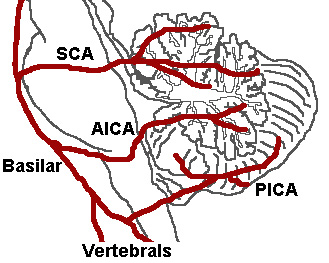- Locked-In syndrome
Infobox_Disease
Name = PAGENAME

Caption = Locked-In syndrome can be caused by stroke at the level of thebasilar artery denying blood to thepons , among other causes.
DiseasesDB =
ICD10 = ICD10|G|46|3|g|40
ICD9 = ICD9|344.81
ICDO =
OMIM =
MedlinePlus =
eMedicineSubj =
eMedicineTopic =
MeshID = D011782Locked-In syndrome is a condition in which a patient is aware and awake, but cannot move or communicate due to complete paralysis of nearly all voluntary muscles in the body. It is the result of a
brain stem lesion in which theventral part of thepons is damaged. The condition has been described as "the closest thing to being buried alive". In French, the common term is "maladie de l'emmuré vivant", literally translated as walled-in alive disease; in German it is sometimes called "Eingeschlossensein". [http://www.cnn.com/2007/HEALTH/conditions/12/14/locked.in/index.html?eref=rss_topstories "Scientists seek to help 'locked-in' man speak"] ,CNN , 14 December 2007]Locked-in syndrome is also known as Cerebromedullospinal Disconnection,cite journal |author=Nordgren RE, Markesbery WR, Fukuda K, Reeves AG |title=Seven cases of cerebromedullospinal disconnection: the "locked-in" syndrome |journal=Neurology |volume=21 |issue=11 |pages=1140–8 |year=1971 |pmid=5166219 |doi=] De-Efferented State, Pseudocoma,cite journal |author=Flügel KA, Fuchs HH, Druschky KF |title= [The "locked-in" syndrome: pseudocoma in thrombosis of the basilar artery (author's transl)] |language=German |journal=Dtsch. Med. Wochenschr. |volume=102 |issue=13 |pages=465–70 |year=1977 |pmid=844425 |doi=] and ventral pontine syndrome.
The term for this disorder was coined by Plum and Posner in 1966.cite web |url=http://www.emedicine.com/pmr/topic189.htm |title=eMedicine - Stroke Motor Impairment : Article by Adam B Agranoff, MD |accessdate=2007-11-29 |format= |work=] [Plum F. and Posner J.B. 1966. The diagnosis of stupor and coma. F.A. Davis Co. Philadelphia, Pennsylvania, USA. 197 pp.]
Presentation
Locked-in syndrome results in
quadriplegia and inability to speak in otherwise cognitively-intact individuals. Those with locked-in syndrome may be able to communicate with others by coding messages by blinking or moving their eyes, which are often not affected by the paralysis.Patients who have locked-in syndrome are conscious and aware with no loss of cognitive function. They can sometimes retain
proprioception and sensation throughout their body. Some patients may have the ability to move certain facial muscles, most often some or all of the extraocular eye muscles.Causes
Unlike
persistent vegetative state , in which the upper portions of the brain are damaged and the lower portions are spared, locked-in syndrome is caused by damage to specific portions of the lower brain and brainstem with no damage to the upper brain.Possible causes of locked-in syndrome include:
*Traumatic brain injury
* Diseases of thecirculatory system
* Medication overdose
* Damage to nerve cells, particularly destruction of themyelin sheath , caused by disease (e.g. central pontine myelinolysis secondary to rapid correction of hyponatremia).
* A stroke or brain hemorrhageTreatment
There is no standard treatment for Locked-In syndrome, nor is there a cure. Stimulation of muscle reflexes with electrodes (
Neuromuscular stimulation ) has been known to help patients regain some muscle function. Other courses of treatment are oftensymptomatic . [NINDS|lockedinsyndrome]Assistive computer interface technologies, such as
Dasher in combination withEye tracking may be used to help patients communicate. [http://polishlinux.org/apps/dasher-keyboard-without-keys/]New
direct brain interface mechanisms may provide future remedies. [Parker, I., "Reading Minds," The New Yorker, January 20, 2003, 52-63]Prognosis
It is extremely rare for any significant motor function to return. The majority of locked-in syndrome patients do not regain motor control, but devices are available to help patients communicate.
Notable case
Parisian journalist
Jean-Dominique Bauby had astroke in 1995, and when he awoke 20 days later he found that his body was almost completely paralyzed: he could control only his left eyelid. By blinking this eye he dictated a letter at a time and in this way he wrote his memoir "The Diving Bell and the Butterfly ".cite web |url=http://www.avclub.com/content/cinema/the_diving_bell_and_the |title=The Diving Bell And The Butterfly | The A.V. Club |accessdate=2007-11-29 |format= |work=] The2007 film "The Diving Bell and the Butterfly" is a film adaptation of Bauby's memoir.Noted cultural references
* (1868) In
Emile Zola 's "Thérèse Raquin ", Thérèse's aunt Madame Raquin develops locked-in syndrome after a stroke. [cite journal |author=Pearce JM |title=The locked in syndrome |journal=Br Med J (Clin Res Ed) |volume=294 |issue=6566 |pages=198–9 |year=1987 |pmid=3101806 |doi=]
* Dalton Trumbo's 1939 novel "Johnny Got His Gun " features a soldier from the WWI period who suffers horrific injury, losing all of his limbs, eyes, nose, jaws and tongue effectively rendering him similar to one with Locked-In syndrome. He eventually learns to communicate via Morse code by banging his head against a pillow.
* Metallica's 1988 song One, based on the concept presented in "Johnny Got His Gun", deals with a soldier suffering from locked-in syndrome.
* Mark Billingham's "Sleepyhead" | http://www.markbillingham.com/sleepy.html, is a crime thriller with the victims suffering from locked-in syndrome.References
Wikimedia Foundation. 2010.
